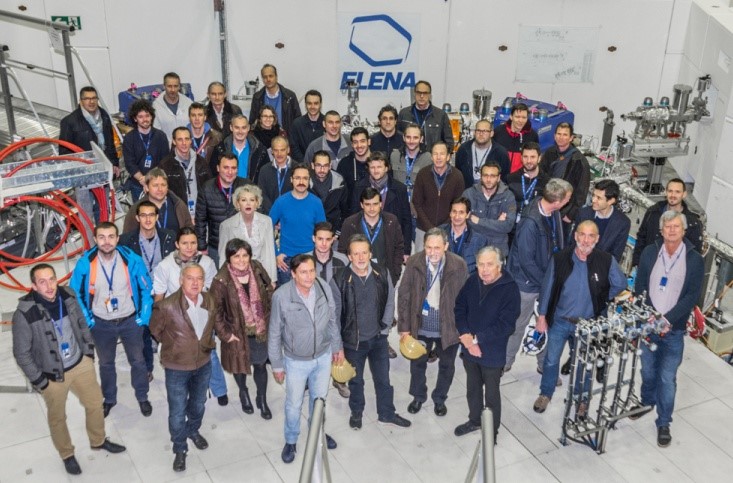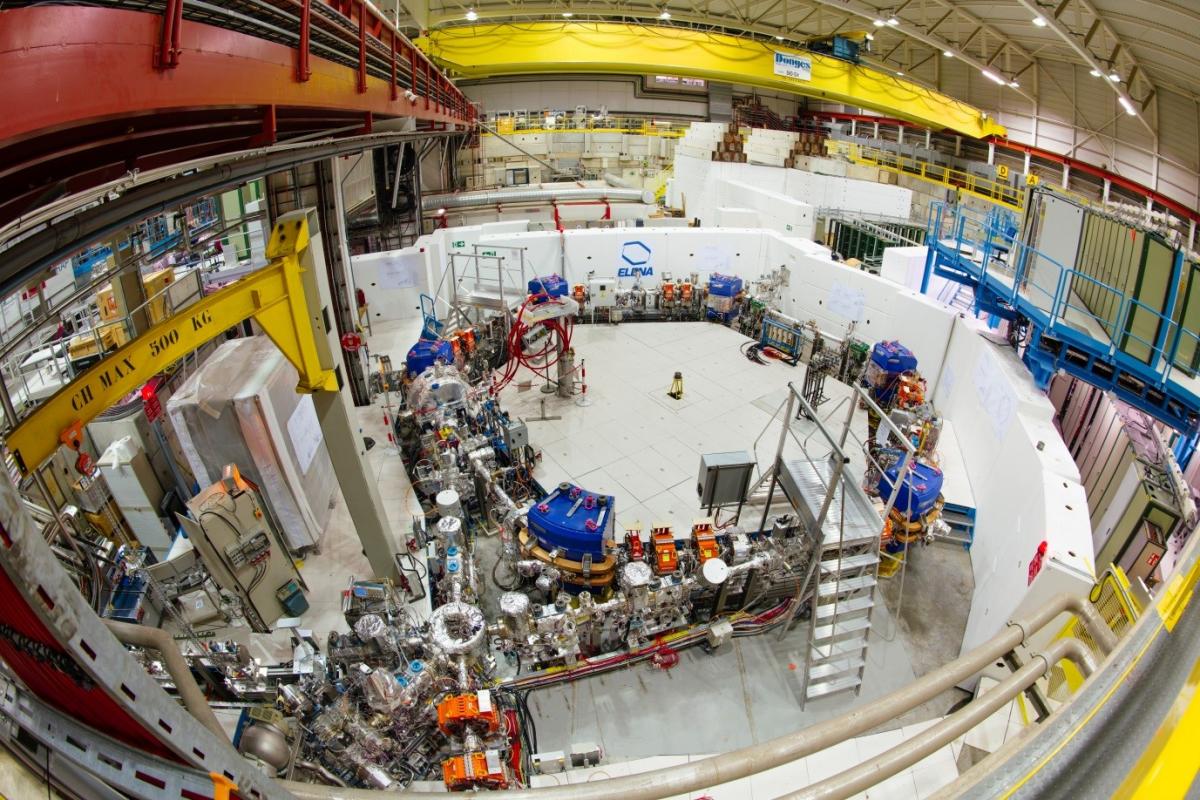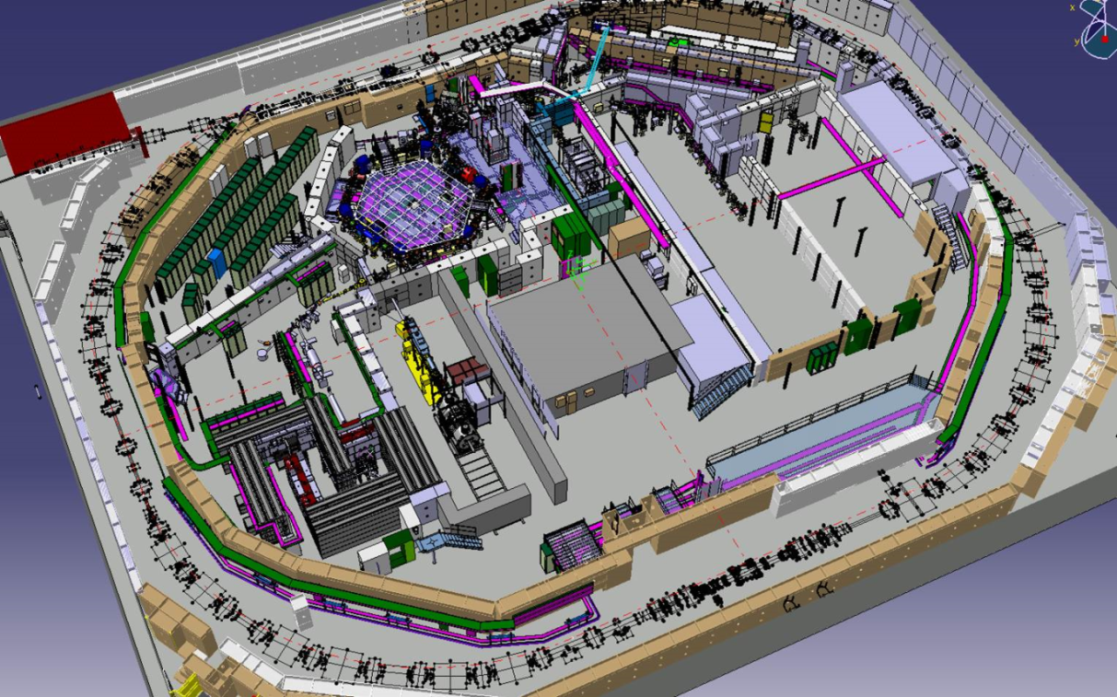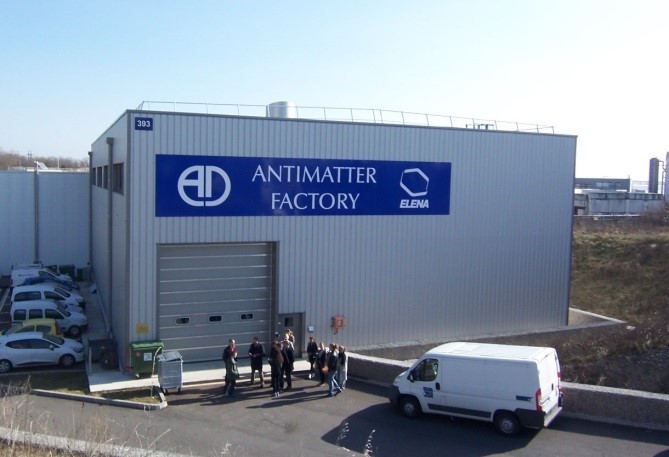The ELENA project
The safety door is closed, see Figure 1. Beam can be sent to the area behind, where the mechanical construction of ELENA -- the Extra Low ENergy Antiproton ring – was finished early November 2016.
And beam - delivered for the commissioning from a special source - is arriving just in front of the ELENA ring ready to be injected.
Figure 1: The closed safety door of the ELENA area with “BEAM ON” and the “ELENA CLOSED” indication. (Image Credit@CERN)
The following image (Figure 2) shows the spot of the very first proton beam on the “BTV” instrument located between the injection septum and the kicker. Already three days after starting the commissioning a first coasting beam was observed for one turn and shortly after for three turns. It took only a few more days to observe the beam over several 10 s of turns. A very first success.

Figure 2: Beam spot on a BTV located between injection septum and kicker. (Image Credit@CERN)
This remarkable milestone is certainly worth to be remembered and therefore to mark the end of the installation phase and the beginning of the commissioning of the new decelerator, a group-photo of all those people present and working for the project has been taken on Monday, November 21st 2016, and is shown in figure 3.

Figure 3: Group photo of some of those people working for the design and mechanical construction of ELENA. (Image Credit@CERN)
Back in July 8th 2014 we reported already in the EP newsletter about the ELENA project (see: ../content/elena-project) which was approved by the Research Board in June 2011.
CERN has a longstanding tradition of pursuing fundamental physics on extreme low and high energy scales. The present physics knowledge is successfully described by the Standard Model along with General Relativity. In the antimatter regime many predictions of this established theory still remain experimentally unverified and one of the most fundamental open problems in physics concerns the question of asymmetry between particles and antiparticles: why is the observable and visible universe apparently composed almost entirely of matter and not of antimatter?
ELENA is a CERN project aiming to construct a small 30.4 m circumference synchrotron to further decelerate antiprotons from the Antiproton Decelerator (AD) from 5.3 MeV down to 100 keV. Whereas in 2014 only the layout of the ELENA ring could be shown, Figure 4 now presents the mechanically finished ring with nearly all its main components enclosed in the concrete shielding wall for radiation protection, all located within the AD hall.

Figure 4: The ELENA ring and its components installed in the AD hall. (Image Credit@CERN)
Controlled deceleration in a synchrotron to energies as low as 100 keV and emittance reduction using electron cooling will allow the existing AD experiments to increase their antiproton capture efficiencies and renders new types of experiments possible. Unfortunately this important piece of equipment is still missing due to delivery problems but is replaced by a straight section beam pipe for closing the ring and completing the vacuum and bake out of the system. Thus the commissioning could start though without the electron cooler. Both H- ions and protons are available from an external source and later antiprotons might be delivered from the AD ring as well.
Commissioning was scheduled to take place from November 14th to the Christmas break. Unfortunately on November 26 the transformer of the source failed which will need a repair of four weeks and therefor the commissioning will continue only in February 2017 still without the electron cooler, which will be installed and tested depending on what has been achieved and on the availability of the device sometime in spring 2017. It should culminate in spring time 2017 with H- or p beams delivered to new experiment Gbar and somewhat later in 2017 with antiproton operation for this experiment, in parallel with continuous improvements of the commissioning conditions. In 2018 ELENA will serve exclusively Gbar whereas the other experiments will get their antiprotons still from the AD, the time consuming procedure for dismounting the present magnetic beam lines and installing new electrostatic beam lines to the existing experiments (see Figure 5) will be done during the long shut down (LS2) lasting from 2019 to 2020. Thus the sole operation of ELENA for all experiments will start most likely in 2021. ELENA will then be able to deliver beams almost simultaneously to all experiments (within one cycle up to four experiments) resulting in an important gain in total beam time for each collaboration.

Figure 5: ELENA and the beam lines to the different experiments in the AD Hall. (Image Credit@CERN)
Very visible to visitors at CERN is the construction of the new building 393. This “Antimatter Factory” hall hosts the kickers for the AD operation which had to be moved out of the AD hall in order to make place for the ELENA ring itself. In addition, it houses storage places for the experiments and a rather small workshop for fast repairs for the experiments when needed. Figure 6 depicts the outside view and a look inside.

Figure 6: Outside and inside the new building 393 – the Antimatter Factory – housing the kickers and storage place for the experiments. (Image Credit@CERN)
In summary, the ELENA is an upgrade of the Antiproton Decelerator (AD) at CERN and is devoted to experiments for physics using low energy antiprotons.
Figure 7 (prepared by Stefan Ulmer for the workshop “Physics Beyond Colliders”, CERN September 2016) conglomerates the possibilities of fundamental physic in the low energy regime of high precision experiments and gives at the upper right and left corner the logos of the six collaborations working or being just installed at the AD/ELENA complex.
The six experiments are named: ATRAP, ALPHA, ASACUSA, AEgIS, Gbar and BASE. Their specific properties and features can be found in CERN’s Grey Book. For instance the experiment BASE approved in 2013, reported in 2015 an improved high precision comparison of the charge/mass ratio for the antiproton-proton system with a fractional precision of 69 parts in a trillion. Moreover the collaboration has invented a novel reservoir trap technique and demonstrated very recently trapping of antiprotons for more than 1 year. Happy birthday to these exotic antiparticles!
Once low energy antiprotons are available - as provided now at the AD and even lower by ELENA in the future - they might be used either as free particles for studying the fundamental properties as charge/mass ratios and magnetic moment or investigated in bound systems, as outlined in Figure 7.
Figure 7: Possibilities of fundamental research with low energy antiprotons. (Image Credit@CERN)
Bound states are:
i) a normal matter atom (e.g. He) with a bound antiproton replacing an electron e.g.
antiprotonic helium,
ii) the exotic antihydrogen atom with an antiproton core surrounded by a positron
and
iii) antihydrogen ions.
In all these cases high precision measurements in the spectroscopic and the gravitational sector investigate fundamental properties and exact interactions eventually in comparison to normal matter. Thus we might understand why there is much more matter rather than antimatter. With ELENA there is a brilliant future to come for basic antimatter-physics to be studied.
